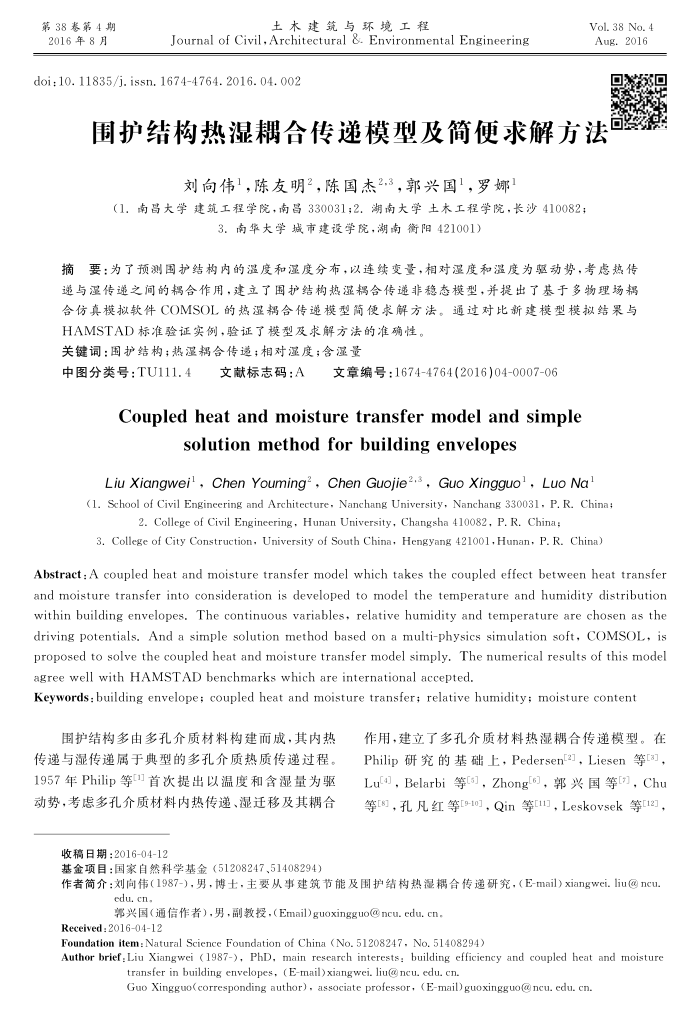您当前的位置:首页>论文资料>围护结构热湿耦合传递模型及简便求解方法
内容简介
 第38参第4期 2016年8月
第38参第4期 2016年8月土木建筑与环境工程
Journal of Civil,Architectural &.Environmental Engineering
doi:10. 11835/j.issn. 1674-4764.2016. 04.002
Vol. 38 No. 4 Aug.2016
围护结构热湿耦合传递模型及简便求解方法
刘向伟1,陈友明2,陈国杰23,郭兴国1,罗娜
(1.南嵩大学建筑工程学院,南昌330031;2.湖南大学土木工程学院,长沙410082;
3.南华大学城市建设学院,湖南衡阳421001)
摘要:为了预测国护结构内的温度和湿度分布,以连续变量,相对温度和温度为驱动势,考虑热传递与湿传递之间的耦合作用,建立了国护结构热湿耦合传递非稳态模型,并提出了基于多物理场耦合仿真模拟软件COMSOL的热湿耦合传递模型简便求解方法。通过对比新建模型模拟结果与
HAMSTAD标准验证实例,验证了模型及求解方法的准确性。关键词:围护结构;热湿耦合传递;相对湿度;含湿量
中图分类号:TU111.4
文献标志码:A
文章编号:1674-4764(2016)04-0007-06
Coupled heat and moisturetransfermodel and simple
solutionmethodforbuildingenvelopes
Liu Xiangwei',Chen Youming”,Chen Guojie",3,Guo Xingguo',Luo Nal(1. School of Civil Engineering and Architecture, Nanchang University, Nanchang 330031, P. R. China:
2. College of Civil Engineering, Hunan University, Changsha 410082, P. R. China;
3. College of City Construction, University of South China, Hengyang 421ool,Hunan, P. R. China)
Abstract: A coupled heat and moisture transfer model which takes the coupled effect between heat transfer and moisture transfer into consideration is developed to model the temperature and humidity distribution within building envelopes. The continuous variables, relative humidity and temperature are chosen as the driving potentials. And a simple solution method based on a multi-physics simulation soft, COMSOL, is proposed to solve the coupled heat and moisture transfer model simply. The numerical results of this model agree well with HAMSTAD benchmarks which are international accepted.
Keywords: building envelope; coupled heat and moisture transfer; relative humidity; moisture content
围护结构多由多孔介质材料构建而成,其内热
传递与湿传递属于典型的多孔介质热质传递过程。 1957年Philip等1首次提出以温度和含湿量为驱动势,考虑多孔介质材料内热传递、湿迁移及其耦合
收稿日期:2016-04-12
基金项目:国家自然科学基金(51208247、51408294)
作用,建立了多孔介质材料热湿耦合传递模型。在 Philip研究的基础上,Pedersen[2],Liesen等[3], Lu4],Belarbi等[5],Zhong[6],郭兴国等[}],Chu 等[8],孔凡红等[9-10],Qin等[11],Leskovsek等[12]
作者简介:刘向伟(1987-),男,博士,主要从事建筑节能及围护结构热湿耦合传递研究,(E-mail)xiangwei.liu@ncu
edu.cn.
郭兴国(通信作者),男,副教授,(Email)guoxingguo@ncu.edu.cn
Received:2016-04-12
Foundation item:Natural Science Foundation of China (No. 51208247, No. 51408294)
Author brief:Liu Xiangwei (1987-), PhD, main research interests: building efficiency and coupled heat and moisturc
transfer in building envelopes, (E-mail) xiangwei. liu(@ ncu, edu. cn
Guo Xingguo(corresponding author) , associate professor, (E-mail)guoxingguo@ncu. edu. cn.